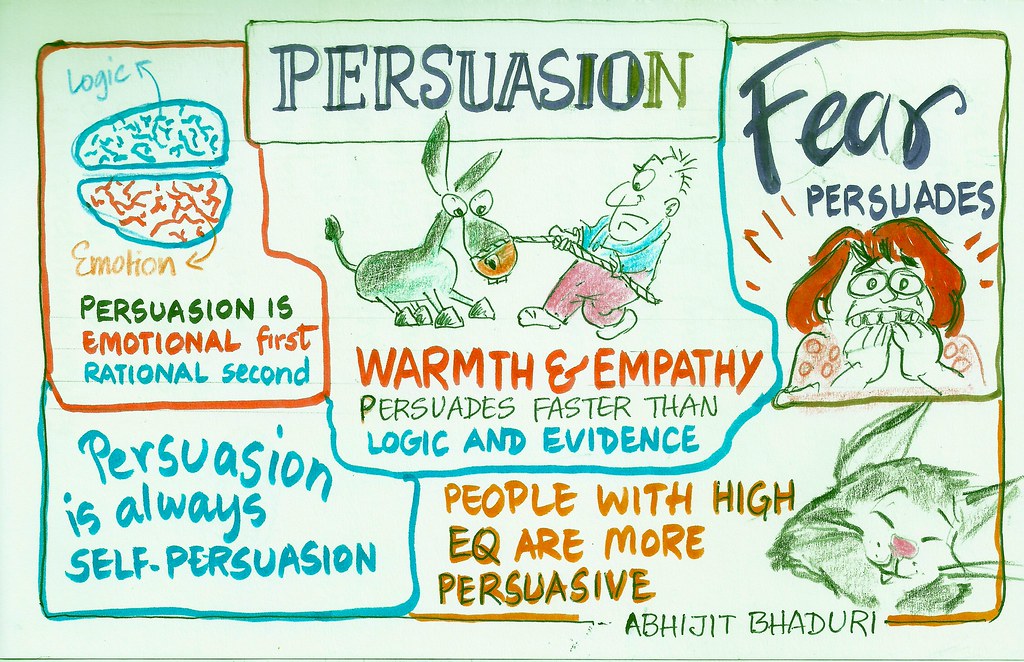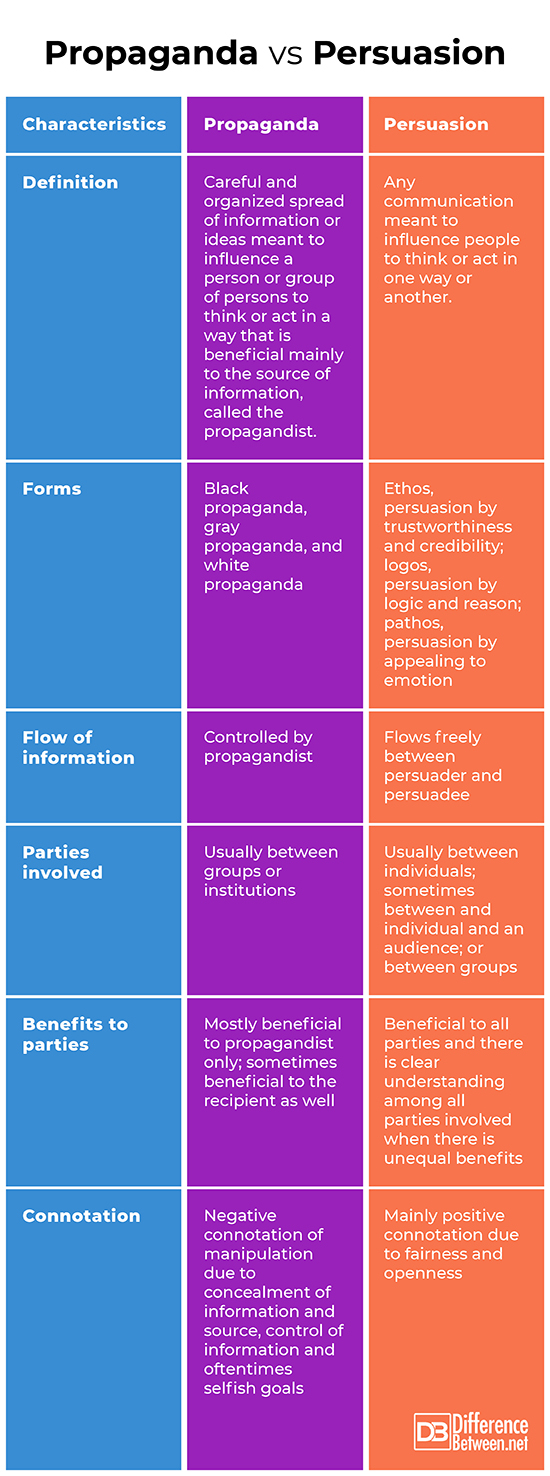Difference Between Propaganda and Persuasion
For many people, recognizing propaganda and persuasion for what they are, and defining them are two different things. The former is so easy and comes so instantaneously and almost subconsciously while the latter is like fumbling in the dark. Broadly speaking, propaganda and persuasion are just two ways to get a person or group of people to think or act in a specific or general manner. This definition seems easy enough and makes it so that propaganda and persuasion are exactly the same. In truth, there are so many ways these two words are defined. Within the context of the communication process alone, definitions vary depending on which element of the communication process is emphasized; the communicator, the message, the recipient or the response of the recipient. Sometimes, pre-existing attitudes color the definition as well. Added to this complication is the fact that propaganda and persuasion use the same media, whether it be art, television, radio, or the internet.
The difficulty exists as well in differentiating the two. One can easily recognize the differences but difficult to put them to words. The two are very similar but they differ very subtly. Some of the differences can be pinpointed in the form that the elements of communication take, but there is overlap even there. Still, with a combination of these elements and how they differ between propaganda and persuasion, it is possible to discern one from the other. Also, part of the difficulty of putting a definition into words is due to the connotation that these two words have which will be looked further into. More about these two terms and their differences are discussed further in the succeeding sections.
What is Propaganda?
Propaganda is a form of careful, organized communication with the intent of the communicator, called a propagandist, to influence a person or group of persons to think or behave differently or to reinforce pre-existing thoughts or behaviors. Primarily, the thought or behavior needs to be advantageous or of some benefit to the propagandist directly or indirectly. It has three forms; black, gray and white propaganda. Black propaganda is when the information being spread is made of lies or fabrications, or when the source of the information is concealed. Gray propaganda is when the source or the truth of the information is ambiguous. Lastly, white propaganda is when both the source and the information itself are verifiable.
Propaganda usually originates from, and is aimed at a large group of people or an institution and as such is considered a societal, religious or political activity. However, the information is controlled in various ways only at the origin of the information, the propagandist. Control of information may start with fabricating it, limiting it or releasing the information at determined intervals.
Sometimes, such as in the case of health campaigns to quit smoking or curbing the spread of diseases, propaganda aims to benefit the recipient more and seems not to have any benefit for the propagandist at all. Even with the arguably benevolent agenda of the propagandist, the systematic and insistent way that the information is disseminated classifies these as propaganda. Mostly though, propaganda only benefits the propagandist, or even when the recipient of propaganda benefits as well, there is still a hidden agenda behind it. Even though the recipient of propaganda takes action willingly, the concealment of agenda, the control of information and the oftentimes selfish goals of the propagandist all give propaganda its negative connotation of manipulation.
What is Persuasion?
Persuasion is a form of communication also meant to influence a person or group to change their minds, behaviors or attitudes, or just to consider a different point of view. According to Aristotle’s famous Rhetoric, persuasion has three forms or modes, ethos, logos and pathos. Ethos is persuasion based on the credibility and trustworthiness of the speaker and the information, logos is persuasion based on logic and reason and pathos is persuasion based on emotion. In the broader perspective, propaganda is a form of persuasion as many propaganda use all three aforementioned forms of persuasion.
Typically, persuasion is an interaction between two individuals, for example a salesman and a prospective buyer, although the persuader can also be a group addressing an audience. On the other hand, a group trying to persuade an individual gives it an air of coercion, or at best is a form of propaganda. Persuasion is a two way process between the persuader and the persuadee and there is a free flow of information between the parties. Most of the time there is also a clear benefit to both parties, and even in cases where the benefits are unequal, this is at least understood by both parties because of the free flow of information. Most importantly, at the end of the attempt at persuasion, the persuadee is free to make a choice to think or act as according to the desire of the persuader or not. These characteristics of persuasion give it mostly a positive connotation of fairness and openness.
Difference between Propaganda and Persuasion
Definition
Propaganda is careful and organized spread of information or ideas meant to influence a person or group of persons to think or act in a way that is beneficial mainly to the source of information, called the propagandist. Persuasion is any communication meant to influence people to think or act in one way or another.
Forms
Propaganda has three forms; black propaganda where source and veracity of information is concealed and the information itself is fabricated, gray propaganda where the source and truth of information are ambiguous, and white propaganda where both the source and truth of the information is verifiable. Persuasion has three main forms; ethos or persuasion by credibility and trustworthiness of the information and its source, logos or persuasion by use of logic and reasoning, and pathos or persuasion by appealing to emotion.
Flow of information
In propaganda, the flow of information is controlled by the source, or the propagandist. In persuasion, information flows freely between persuader and persuadee.
Parties involved
In propaganda, the propagandist is usually a group of people or an institution such as a church, government or corporation and it is also aimed at groups of people. Persuasion is an interaction usually between individuals but may also be between individual as persuader and an audience or between groups of people.
Benefits to the parties
In propaganda, the changes in the thought and behavior of the influenced person or group is most usually to the benefit of the propagandist only and rarely to the benefit of the recipient as well. In persuasion, the benefits are usually equal between the parties or, when unequal, are at least clearly understood by all involved.
Connotation
Propaganda has a negative connotation of manipulation due to the concealment of information and its source, the control of information and the oftentimes selfish goals. Persuasion has a mostly positive connotation due to fairness and openness.
Propaganda vs Persuasion
Summary
- Propaganda and persuasion are two ways of getting a person or group to think or behave in a specified or general way.
- In propaganda, the resulting behavior is almost always beneficial only to the propagandist and only sometimes beneficial to the recipient as well. The flow of information is controlled by the propagandist, either through fabrication, limitation or staggered release of information.
- In persuasion, both the persuader and persuadee benefit and there is a clear understanding between the parties involved. Information flows freely between parties as well.
- Although propaganda is basically a form of persuasion, it has a negative connotation of manipulation while persuasion is generally neutral or positive.
- Difference Between Hematoma and Melanoma - February 9, 2023
- Difference Between Bruising and Necrosis - February 8, 2023
- Difference Between Brain Hematoma and Brain Hemorrhage - February 8, 2023
Search DifferenceBetween.net :
Leave a Response
References :
[0]Aristotle. Rhetoric. Translated by W. Rhys Roberts. Mineola, NY: Dover Publications, Inc., 2004. Print.
[1]Jowett, Garth S., and Victoria O’Donnell. Propaganda and Persuasion, 5th Edition. Los Angeles, CA: SAGE Publications, Inc., 2012. Print.
[2]Perloff, Richard M. The Dynamics of Persuasion: Communication and Attitudes in the 21st Century. New York, NY: Routledge, 2010. Print.
[3]Image credit: https://upload.wikimedia.org/wikipedia/commons/f/fd/Propaganda_Poster_in_North_Korea.jpg
[4]Image credit: https://live.staticflickr.com/4463/23880186778_1b5cfa88df_b.jpg



